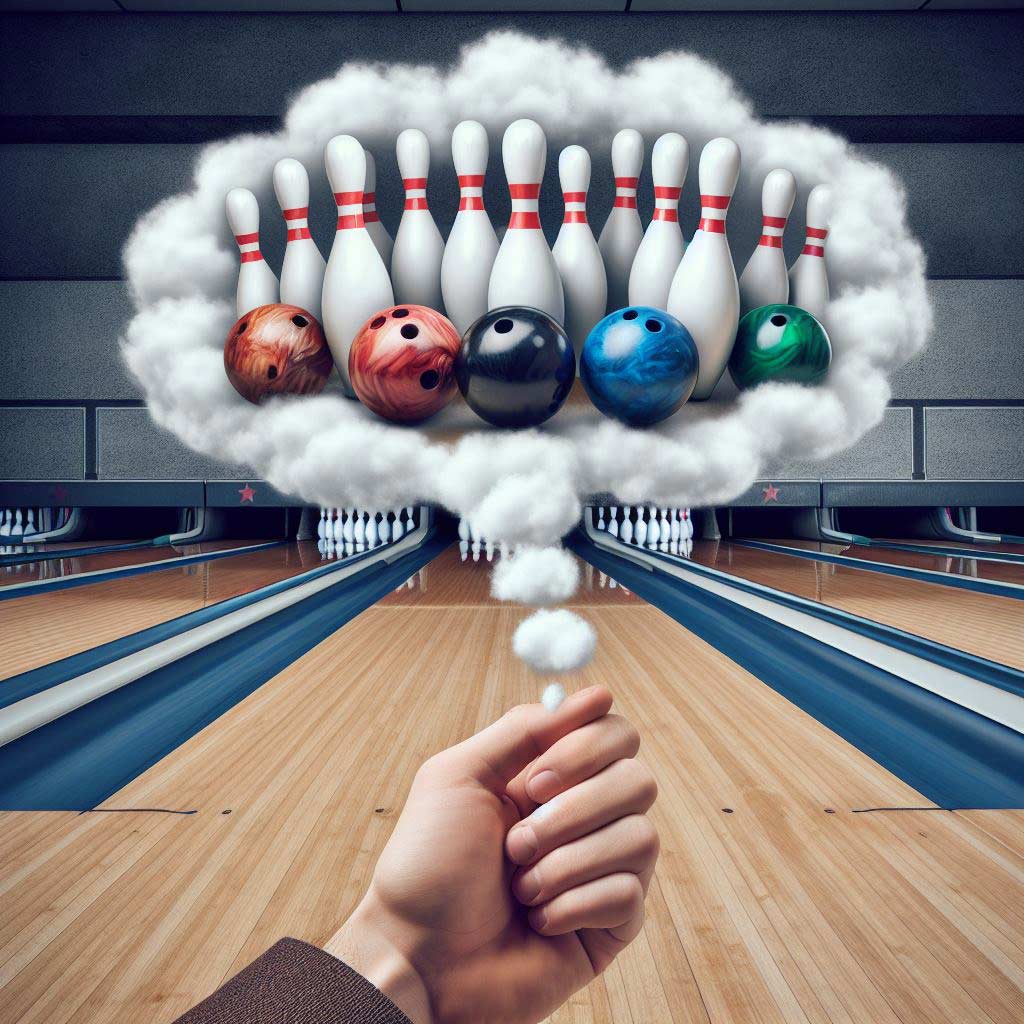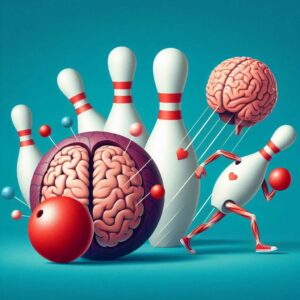Bowling is 90 percent mental and only 10 percent physical—according to the late professional bowler Mark Roth.
While bowling skill and physical consistency are important, many bowlers realize that what separates the good from the great lies between the ears.
A 2020 survey of amateur adult bowlers in the US found that nearly 60 percent admitted to struggling with nerves, loss of focus, or confidence issues that negatively impacted their consistency and scoring.
Yet with the proper bowling psychology strategies, bowlers can learn to strengthen their mental stamina and mindset for the game.
Developing your mental toughness leads to incredible gains in consistency, average bowling scores, and passion for the sport. This guide covers tactics to master your bowling mental game.
Managing Nerves and Anxiety in Bowling
Bowling in leagues and tournaments can bring different pressures than practice games with friends.
The stakes feel higher and no bowler wants to succumb to nerves in important games or your team. As adrenaline begins pumping, even experienced bowlers struggle sometimes to manage anxiety.
Pay attention to your self-talk and attitude before approaching the lane. Try to frame the stakes more positively as excitement rather than fear. Otherwise, doubt and performance anxiety often become a self-fulling prophecy.
While every bowler needs to find methods that work for them specifically to ease anxiety, here are some researched tips:
Visualization
Close your eyes while waiting for your turn and visualize your ideal strike shot playing out.
Imagine the flight path your ball takes as it glides straight toward the pins before exploding the pocket powerfully on impact.
Envision pins bouncing around triumphantly. Studies demonstrate that visualization and mental rehearsal activate bowling-specific neuro pathways to prime your body calmly for a smooth, accurate roll.
Square Breathing
When feeling nervous energy course through your system uncontrollably, a simple square breathing exercise can hit the reset button by activating your parasympathetic system.
Inhale slowly while counting to 4. Hold your breath for another slow count of 4. Exhale your breath again to a count of 4.
Finally, pause without air briefly before repeating. Just 2 minutes of square breathing clears your mind, and heart rate and allows you to address bowling anxiety.
Process Over Outcome
Classic sports psychology research shows that maintaining an external focus yields far greater outcomes than internal worry.
This means concentrating on the tangible process required in every roll – your stance, push-away, backswing, and release rather than worrying whether the ball reaches the pins.
Avoid thoughts on desired scores or competitors and direct attentional control to the components that lead to strikes. Staying focused shot by shot keeps nerve-induced mechanics from creeping into your game.
Building Consistent Self Confidence
A bowler’s attitude impacts performance exponentially, yet staying positive presents challenges when you’re having an off day.
Pay attention to inner critical voice and judgmental self-talk that screams “I stink today!” after a gutter ball.
That commentary distracts you mentally down a spiral of mounting pressure while destroying any glimmers of confidence left. Shut down the unhealthy self-criticism immediately if you want any chance of turning things around mid-game.
Constructive Self-Talk
Actively transform negative self-talk by pausing after setbacks, taking a breath, and restating something encouraging instead like “I’ve got my next frame.
Time to focus.” Speaking to yourself compassionately builds confidence through rough stretches while poor inner monologues manifest poor results.
Also, be sure to celebrate strikes and triumphs mentally! Tell yourself aloud “Great roll!” or “Perfect form there, nicely done.” Positive self-reinforcement incentivizes your brain and body to repeat winning techniques.
Pre-Game Rituals
Specific routines completed before every match serve as mental cues that you’re prepared, centered, and ready to thrive.
Take 1-2 minutes before stepping up to bowl for centering tactics like visualizing the lane, breathing intentionally with box breaths, or meditatively repeating a helpful mantra like “Smooth and steady.” Help your mindset catch up to the ideal performance mode.
Pre-Shot Ritual
Similarly, lock down reliable cues preceding every single roll from your starting stance to ball grip.
Keep actions the same way no matter your last frame’s success to build dependability and trust in yourself through repetition. Confidence blossoms knowing your pre-shot routine gives you your best chance at strikes.
Developing Mental Toughness Through Practice
Practice games present the perfect opportunities to challenge your mental stamina, concentration abilities, and resilience which all build toughness for tournaments and league play.
Don’t just bowl mindlessly for hours then leave wondering why focus falters when games get tight. Deliberately strengthen mental muscles through these drills:
Lowest Score Wins
Play a game against friends where the bowler with the LOWEST score after 10 frames gets bragging rights and a drink bought for them.
Having to mentally flip stress over gutter balls and open frames into positive excitement makes for hilarious, pressure-filled games that keep you completely tuned in.
3 Hour Practice Session
Many local bowling alleys offer promotional deals like $10 for 3 hours. Mimic a mini-marathon session at home to expand concentration capabilities and mental endurance.
After just a single 3-hour training block, typical 1-hour league games mentally feel like a piece of cake.
Score Tracker Sheet
Note the score for every frame of every game on paper rather than just mindlessly inputting it into the computer.
Tracking every frame’s running total boosts engagement since bowlers intrinsically strive for personal best when data is front and center. Celebrate new high scores per game to feed your bowling passion.
Reframing Mistakes and Learning From Errors
Mistakes happen. Even professional bowlers fail to strike every frame. Yet your power lies in how mentally you process and reframe gutter balls or open frames after they occur.
Knee-jerk reactions of beating yourself up, mentally checking out, or seeping doubt into the next frame all stem from destructive attitudes towards setbacks.
The healthiest bowlers analyze their errors calmly like detectives seeking clues for improvement opportunities rather than judging themselves. Then they consciously decide to bounce back stronger and wiser next attempt through application.
Analyze Without Judgement
Go through possible reasons execution missed the mark without blame or labeling like “I always mess this up!”
Consider elements like: Did you drift left? Get under the ball? Fail to stay down at the release point? Any number of mechanical, physical, or mental factors might contribute to the bad roll that you can now adjust.
Learn From Errors
Every frame holds valuable takeaways for enhancement so avoid wasting opportunities by remaining present. Think through helpful cues you can implement next frame and commit to process goals like “This time, stay taller through your backswing.” Seek growth inherent in self-analysis.
Reset Quickly
Lingering mentally on past mistakes kills your upcoming frame’s potential before even rolling.
When going through your pre-shot routine for the next attempt, consciously affirm your readiness. Tell yourself “Fresh frame, fresh start.” Processing happens in between rolls – when up next, full attention stays here and now.
The Bottom Line
Arm yourself mentally as a bowler by implementing even just a couple of strategies covered here for mastering your psychology of bowling and performance.
Tackle unhealthy emotions, and unhelpful thinking, build laser focus, learn optimism, and bounce back faster after imperfection.
Developing greater mental fortitude and inner confidence pays untold dividends across not just bowling but your life too.
You start carrying a competitive mindset fueled by passion into every endeavor. So train the mind as you train your bowling skills for maximizing both consistency and joy each frame and each day.
Frequently Asked Questions
How do you mentally prepare for bowling?
To mentally prepare for bowling focus on relaxation techniques like deep breathing, clearing your mind by focusing on your senses, and positive self-talk. Visualize making great shots and adopt helpful pre-shot and pre-game rituals. Stay focused on process-based cues you can control over worried about scores.
What is mental game strategy?
A mental game strategy refers to activities and thought processes bowlers implement to consistently stay confident, motivated, and focused in competitive, stressful, or challenging situations on the lanes. This includes pre-performance routines, mindset adjustments, goal-setting methods, positive self-talk tactics, and strategies to move on quickly after setbacks or mistakes.
How do you do the bowling trick?
A popular bowling trick shot involves rolling your ball backward between your legs down the lane to strike the pins. This takes lots of practice to aim accurately. Other trick shots include behind-the-back rolls, hook shots that go around obstacles placed right of the lane, and chain reaction stunts using contraptions to ultimately knock down pins.
What is a Baker bowling game?
Baker bowling games have teams of bowlers who roll each frame rather than having individuals play full games. So the lead-off bowler rolls the first frame, then the second teammate plays the 2nd frame, and so on until the 10th frame when the lead-off bowler finishes up. This format keeps more bowlers actively engaged.
How many hours should I practice bowling?
To see continual improvement as a bowler, practicing 2-3 times per week for 2-hour sessions on average allows enough repetition for skill development without risking injury through overuse. Supplement with mental training and fitness conditioning on off days too.
How can I get better at bowling fast?
To improve quickly as a bowler, get instruction from a coach on developing an accurate, high-quality technique from the start. Then focus practice on challenging yourself frequently by playing games on different lane oil patterns rather than always playing on typical house shots. Train your adjustment skills and versatility.
How can I improve my mental game?
Improving your mental game involves learning skills around constructive self-talk, quick bouncebacks after mistakes, heightened concentration abilities during play, routines to build confidence, learning mindset shifts that prime optimal performance, goal setting, and motivational techniques. Develop mental toughness through deliberate training.
What is the hardest mental game?
Chess is considered one of the most mentally challenging competitive activities humans play requiring strategic thinking, intense focus over long periods, pattern recognition abilities, mental calculations to deeply analyze constantly evolving scenarios, and player psychology to try to gain advantages. The complexity taxes working memory and fluid intelligence fully.
Which game can train your brain to think strategically?
Games like chess, go, shogi and other highly analytical strategy-based board games requiring planning out sequences of optimal decisions provide fantastic brain training for enhancing skills around strategic thinking, focus, working memory, fluid reasoning, and recognizing patterns. The more possible scenarios to think through the better too.





